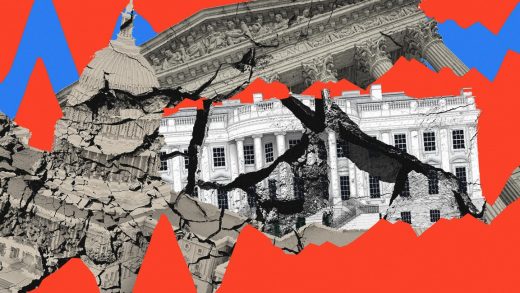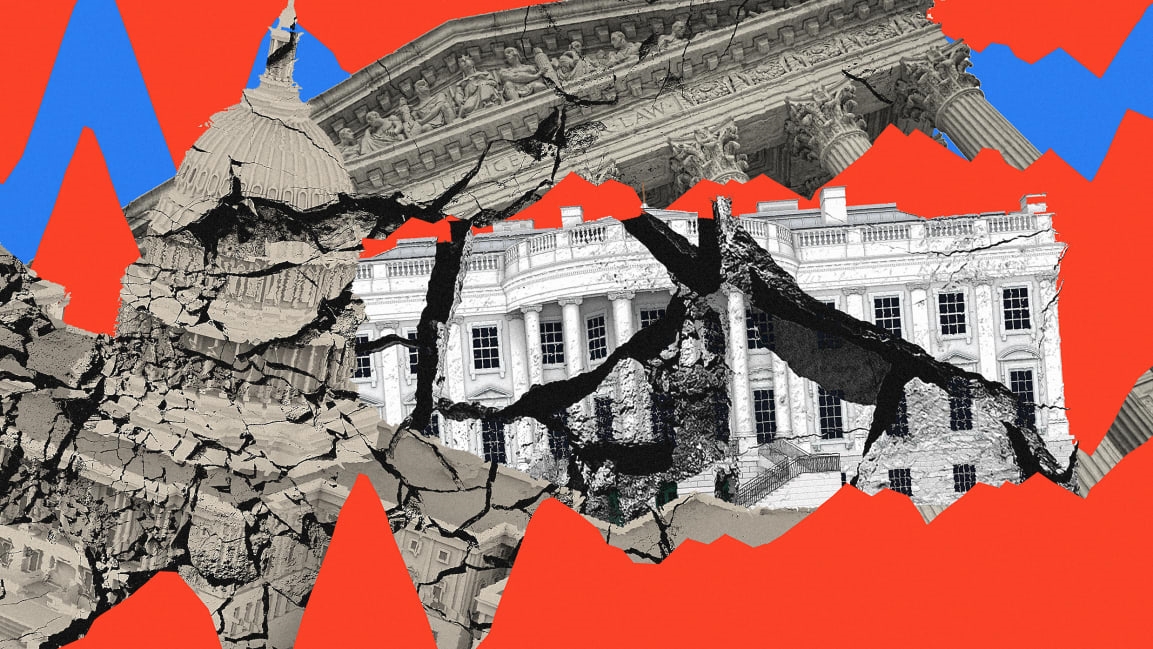Trump shattered American democracy. Designers can help bring it back
“Democracy will save itself with the average man and woman by proving itself worth saving.”
— FDR Radio address, November 4, 1938
Trust in government was already bottoming out before the Trump era, thanks in part to government’s struggle to move into the digital era, which I have written about before. Adding to that now with four years of devaluing civil servants, replacing experts and seasoned public servants with big business CEOs and rich donors, and a nonexistent federal response to the pandemic has only made things worse. Public trust in government was near historic lows in 2019 with only 17% saying they trust the federal government to do what is right. A more recent poll found that the majority of Americans—59%—have not very much or no trust in the federal government.
With a new administration in place, how do we begin the process of repairing our democracy? A large piece of that relies on ensuring that government can deliver what people need. That not only can government help the old and the sick, but that a social safety net exists and works. That those who are the most vulnerable do not need to live in fear of losing their jobs, homes, and livelihood because government will be there to catch them when they fall. Crashing unemployment databases and stimulus checks that never arrive have not helped tell the story of a functional government that values the American people. But the Biden administration has the ability to change the narrative.
The United States has spent much of our history wrestling with what democracy should look like. Central to that question is the role government should play, and how it should play it. In every administration, the answers to these questions vary. This push-and-pull sometimes even surfaces within political parties. National, federally funded childcare almost came into being under Nixon. In 1971 the Comprehensive Child Development Act passed the Senate with overwhelming bipartisan support, but Pat Buchanan—then a White House adviser—ensured that Nixon not only vetoed the bill, but pilloried and buried it. Buchanan insisted that having the government in the childcare business would lead to a Soviet takeover. More likely he wasn’t too thrilled about white middle class women joining the workforce and leaving the childcare to someone else.
Many of the programs we have come to see as an integral part of the fabric of American life—social security, medicare—came into existence under FDR, guided by the ideology that the government’s role is to help those who may not be able to help themselves, such as the old or infirm. But the 1970s brought a sea change in how Americans thought about government, which coalesced under Reaganism in the 1980s and has muddled the national conversation about government’s role ever since. In his book Evil Geniuses, Kurt Andersen tells the story of how the federal government came to be seen as “the man,” the establishment, the thing that rugged individualists should fight against. By the 1980s, President Reagan famously quipped that “the nine most terrifying words in the English language are, ‘I’m from the government and I’m here to help.’”
But at the same time, as a Gen-X-er, I came of age in an era stuffed with conflicting media portrayals about the government. Government was corrupt (Abscam, Watergate). Government was stupid ($640 toilet seats). Government was bad at fraud detection and could be played by layabouts who took limos to cash their government checks (“welfare queens,” which was itself a racist stereotype). Government was creepy, knew less than teenagers, and ruined everyone’s good time (ET, War Games).
Now here we are, mid-pandemic, mid-economic crisis, post-election, ready to begin the conversation anew. The generation who grew up with stories of government excess, dysfunction, and malfeasance is now the generation who will, in many cases, be taking the reins at federal agencies. But as the Biden administration comes into power, people need government in a way they perhaps haven’t since the Great Depression, when the federal government joined together in an effort to lift the nation out of crippling unemployment, hunger, homelessness, and despair. The stage is set for the administration to take steps to renew the people’s faith in government, and along with it, trust in democracy. But where to start?
First, government needs to prioritize service design. Agencies like 18F and the United States Digital Service (I worked previously at the latter)—two efforts to bring seasoned technologists into federal government in order to evangelize and practice their craft—have made good progress in getting federal agencies to reframe their missions for the digital age, but much work remains. Basic things like easy-to-navigate sites, short applications for benefits, and communication about where people are in whatever process they’re applying for will go a long way in telling the story of a government that is modern, alert, and responsive to the needs of the people.
The position of CTO of the United States, created under President Obama, was left vacant under President Trump until 2019. Under Obama, three different CTOs with varied backgrounds took the role in different directions, though all focused on open data, open government, and upgrading government technology. The current CTO unfortunately lists quantum computing, autonomous vehicles, and commercial drones as his areas of focus, though where those might be applied in government and to what end is unclear.
The next CTO of the United States would do well to set new standards for government responsiveness. For example, a mandate that all government forms can be completed in under 20 minutes would revolutionize how agencies think about the information they truly need to serve their clients. The Obama administration mandated plain language. The Biden administration should take that a step further and set metrics for customer service. No citizen should wait more than a few minutes on hold to speak with a government agency. No American should wait longer than six weeks for something to be processed. Some state governments have been working toward same-day approvals for food stamps or cash assistance. The federal government needs to do the same.
Second, government needs to practice Radical Responsiveness, as coined by Dr. Tressie McMillan Cottom in her recent essay. This means responding to the world as it is, not as we would like it to be. This is surprisingly difficult in government, in part because government often lacks access to meaningful data or the user voices that could help inform a radically responsive organization. Congress doesn’t run out and perform usability tests before they pass a new bill. Many agencies have dashboards that monitor how the agency is doing, but the dashboards are often based on self-reported data, and as a result all systems are always green—in government everything is great all the time!
But a Biden administration could take steps to ensure that all agencies collect and apply meaningful data to any policy decisions, and that they monitor the effects of those policy decisions and tweak accordingly. They could also require that no policy gets implemented without first conducting research with real people, and then taking steps to provide policy makers with the necessary access to users. While I was at USDS, my team conducted myriad interviews with people going through all different parts of the immigration process, including the civil servants who interviewed applicants, or who otherwise helped move applicants through the system. Those interviews informed how that process could be improved, made more transparent, and less stressful. Imagine what a difference it would make if that kind of research could be brought to bear on policy decisions from the beginning.
The ways government gathers user input has evolved over the years. Lincoln used to throw open the doors of the White House to hear from Americans. More recently, unions gave voice to how workers were doing. Lobbyists speak for special interests and big business. And of course, people can always call or write their representatives. But today, none of those methods provide a comprehensive view of real people’s experiences. And lawmakers, their offices, and federal agencies are not typically staffed with armies of user researchers who can whip up a user study in a few hours. Without real people’s voices, policymakers lack not only a deep understanding of people’s lived experiences, but also miss out on the very human empathy response that gets triggered upon hearing a real story from a real person.
Instead, over the past four years we have seen what it looks like when government is motivated by greed, ego, and power. Imagine if instead government’s actions were driven by the needs of real people, and the desire to help them. The Biden administration has the opportunity to set the stage accordingly.
None of this can happen without civil servants and political appointees steering the ship. Government needs people with the skills to not only capture but also accurately interpret data, to establish feedback loops for policy makers, to conduct user research, and to set success metrics. And to truly reflect the will of the people, these new staffers need to look like America. When you walk into a government office it should be like walking on to a public bus or a subway car: people from all walks of life, a whole rainbow of human experience, coming together to serve the nation.
In The Atlantic recently, Adam Serwer writes that “Biden must also remind Americans that the government can serve the people, and not just the ambitions, avarice, and ego of its leader.” To truly serve the people, government first needs to care about people, listen to them, understand how they are doing and where they need help, and test what useful help looks like. Product managers, service designers, data scientists, engineers, user researchers –– the country needs you. Government needs you. Our democracy depends upon it.
(24)



